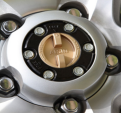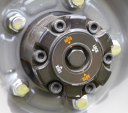
How do the auto hubs on 4X4 vehicles work
Old Style - Hub or Freewheeling Hubs
Part-time four-wheel drive vehicles come in a variety of configurations with a variety of means for selecting 4WD. One of the older options are vehicles fitted with freewheeling hubs. When locking the old-style hub to engage 4WD this required the driver to stop and get out of the car and physically turn the handle on the both hubs, not nice if it is raining or the hub is buried in mud or under water.

You may of seen these hubs on the older Toyotas, Troop Carriers and Land Cruisers.
How do freewheeling hubs work?
Freewheeling hubs or locking hubs engage or disengage the front axle half shaft from the hub of the front wheels. This allows the 4WD to behave in the same fashion as a conventional two-wheel drive car with only the rear wheels being 'driven'. It is only when 4WD is selected and the hubs set in the 'locked' position that the vehicle operates as a four-wheel drive - with power being applied to all wheels.
The freewheeling or locking hub contains a spring-loaded collar that slides inwards and meshes with the front axle half shaft when the actuator is set to 'Lock'. When the actuator is set to 'Free' the front wheel spins independently of the front drive shafts and differential and the car is virtually a 2WD. When the actuator is set to 'Lock' the front wheels, drive shafts and differential are coupled as one unit. Once the transfer case has been engaged and High 4x4 or Low 4x4 selected then the car is operating in 4WD. Learn more about 4WD training
Selecting 4WD in a car fitted with freewheeling hubs involves two separate actions. The hubs must be 'locked' and the transfer case must be engaged to either H4x4 or L4x4. If 4x4 has been selected inside the car and the hubs are still in the free position the front differential and drive shafts are turning and being 'driven' but the car is still in 2WD because the hubs have not been coupled with the rest of the drive train. It makes no difference which action occurs first - locking the hubs or engaging four-wheel drive.
New Style Automatic Locking Hubs - Be careful they can be tricky

You will find these hubs on the newer model Toyotas, Troop Carriers. These can be manually locked in with a wheel brace.
With the new style auto locking hub you can select 4WD by moving the gear stick into H4 or L4, but you can only do this when the vehicle is stationary. This is now done electronically as you select 4WD, if the electronics fail and you can’t select 4WD and you have the new style hubs you can manually lock the hubs by using the wheel brace to turn the nut in the centre of the hub to the lock position. If you have locked the new style hub manually in the Lock position you can drive on sealed roads but not in 4WD. Never drive in 4WD on sealed road.
If you lock the hubs in manually with a wheel brace, then you can select H4 as you are driving but if you want L4 stop the car and select L4. If you drive allot of dirt and sealed roads then leave in lock position and select H4 for dirt and 2H for sealed roads. Always change to 2H for bitumen roads.
Automatic Locking Hubs
Automatic hubs work on the same principle as freewheeling hubs without the need to exit the car to manually turn the actuator. Many newer 4WD's come with this as standard equipment. Very simply these units self-engage 'on the fly' when 4WD is selected within the cab. They are usually disengaged by reversing once 4x4 has been deselected.
Some people like automatic locking hubs for the safety factor. With freewheeling hubs, it is possible to select 4WD inside the cab thinking that the hubs are 'locked' and then come across a bog hole only to find your hubs are in the free position and you are still in 2WD. Freewheeling hubs were designed to reduce friction and the amount of moving parts in four-wheel drive vehicles. Learn more about 4X4 recovery course
Why have Free Wheeling Hubs at All?
Freewheeling hubs were designed to reduce friction and the amount of moving parts in four-wheel drive vehicles. Savings won’t be huge by running with the hubs in the 'Free' position, having fewer moving parts also results in lower noise levels and a quieter ride with less vibration from the drive train.
When to Lock your Hubs
Your freewheeling hubs can be permanently set to the locked position without any adverse effects. This means the vehicle is always ready to engage 4WD and you don't have to get out of the car to turn the actuator. Many station and mining vehicles spend their entire existence with the hubs locked. If you drive mostly on bitumen and only choose to run with the hubs in the free position, then it's recommended to lock the hubs occasionally to provide 'splash lubrication' to the drive shafts.
Some owner’s manual recommends driving at least 15km / 20km per month to provide lubrication. The manual also insists that the hubs are run in the same position on each front wheel i.e.: both locked or both free.
In practise we lock the hubs whenever we anticipate the potential for having to use four-wheel drive and generally whenever you drive on unsealed roads. There is nothing worse than having to climb over the bonnet or wade through knee deep in mud to lock the hubs because you didn't get through that last washout in 2WD. We will normally drive on the highway with the hubs in the free position and lock when drive on unsealed roads.
When Not to Engage Four Wheel Drive
Part-time four-wheel drive vehicles are designed to operate in conditions of poor traction, on steep hills and on loose or unreliable surfaces. Making tight turns on bitumen or concrete can damage drive line components and wear out tyres. A part-time four-wheel drive rotates the front drive shafts and rear drive shafts at the same rate. The front wheels need to rotate at a greater rate than the rear wheels to make a turn.
Because the front and rear drive lines are coupled and operating at the same rate things begin to get ugly. Steering becomes difficult as the front end 'understeers' while the drive line starts to 'bind'. Something has to give and this 'driveline binding' will result in jerky movement, tyre spin and eventually component failure. Usually expensive components like axles, differential gears or transfer gears.
Driving in four-wheel drive on sealed surfaces is to be avoided unless the car is designed as a constant 4WD. If your car has freewheeling or automatic locking hubs it is a part time 4x4. Learn more about 4WD training
Good Habits
- We check the position of the hubs every day just by keeping them clean. A dab of paint on the indicator arrow and the preferred position (either locked or free) makes them easy to glance at when you walk past.
- Regularly drive with the hubs locked to lubricate the drive shafts.
- Lock the hubs and select H4 whenever drive on unsealed roads L4 before attempting any risky manoeuvre’s and be absolutely certain of your hubs position.
Ian Van Munster is a 4WD instructor and has many years driving trucks and road trains to remote locations in the Northern Territory.